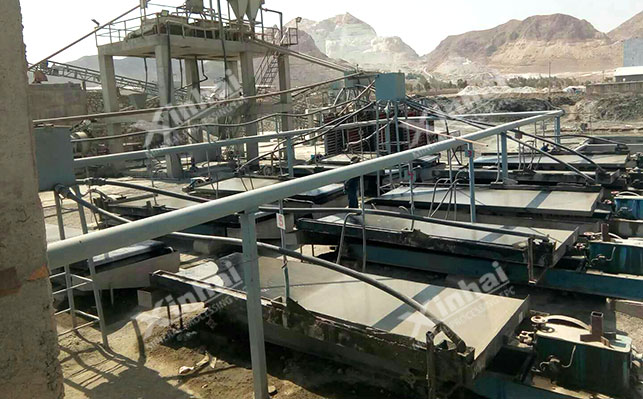Oxidized lead-zinc ore is an important mineral resource for extracting metallic lead and zinc. Lead and zinc are widely used in metallurgy, chemical industry and other fields. The mineral composition of oxidized lead-zinc ore is complex. Choosing a suitable beneficiation process can improve resource utilization, concentrate grade and beneficiation plant revenue. Common beneficiation methods for oxidized lead-zinc ore include flotation, leaching and gravity separation. This article will compare these three beneficiation methods and tell you how to choose a suitable beneficiation process.
1. Flotation method

(1) Process flow
The main process of flotation process includes pulp preparation, reagent addition, flotation process and concentrate collection. In the flotation process, the ground ore is first mixed with water to form a pulp, and then reagents such as collectors (such as xanthate), frothers (such as pine oil) and regulators (such as lime, cyanide) are added. The collector makes the surface of the target mineral hydrophobic, the frother stabilizes the bubbles, and the regulator is used to adjust the pH of the pulp and inhibit unwanted minerals. In the flotation machine, air is introduced into the pulp, and the bubbles attach to the hydrophobic minerals, bringing them to the surface to form a foam layer. Finally, the foam rich in the target mineral is collected to obtain the concentrate.
(2) Reagent system
The design of the reagent system is a key link in the flotation process. The correct selection of collectors and frothers can change the surface properties of the mineral and affect the stability and size of the bubbles. The regulator can change the chemical environment of the pulp. In the beneficiation process of lead-zinc oxide ore, the commonly used collector is xanthate, the foaming agent is pine oil, and the adjusting agent is lime and cyanide.
2. Leaching method
(1) Process flow
The main process of the leaching process includes ore pretreatment, leaching process, leachate purification and metal recovery. First, the lead-zinc oxide ore is crushed and ground to increase the specific surface area of the ore and improve the leaching efficiency. Next, the ore needs to be mixed with a leaching agent (such as acid, alkali or bioleaching agent) to dissolve the metal into the solution. After the leachate is purified, the metal is recovered by electrolysis, displacement or solvent extraction.
(2) Common leaching methods
There are many types of leaching methods, including acid leaching, alkaline leaching and bioleaching. Acid leaching is suitable for treating ores containing acidic leaching agents, such as sulfuric acid leaching zinc oxide ore; alkaline leaching is suitable for treating ores containing alkaline leaching agents, such as sodium carbonate leaching lead oxide ore; biological leaching uses the metabolism of microorganisms to dissolve metals, which has environmental advantages.
3. Gravity separation

(1) Process flow
Gravity separation processes mainly include screening, jig separation and shaking table separation. First, the ore is graded by screening equipment and then enters the jig or shaking table for separation. The jig uses the rising and falling action of the pulsating water flow to stratify the ore in the vertical direction; the shaking table uses the inclined water flow and mechanical vibration to stratify the ore in the horizontal direction. Finally, by collecting minerals of different densities, concentrate is obtained.
(2) Applicable conditions of gravity separation
Gravity separation is suitable for treating coarse-grained and medium-grained minerals, especially minerals with large density differences. For fine-grained minerals, the recovery rate of gravity separation is low and it usually needs to be combined with other mineral separation methods.
1. Advantages and Disadvantages of Flotation
Advantages: High efficiency in separating oxidized lead and zinc minerals, suitable for a variety of mineral combinations; can process fine and micro-fine minerals.
Disadvantages: High reagent cost, requiring a complex reagent system; sensitive to changes in ore properties, requiring frequent process adjustments.
2. Advantages and Disadvantages of Leaching
Advantages: Can process low-grade ores, with a high leaching rate; obvious environmental advantages, suitable for processing complex ores.
Disadvantages: Long leaching time, complex process; requires processing of a large amount of leachate, with high cost.
3. Advantages and Disadvantages of Gravity Separation
Advantages: Simple equipment, low cost, easy operation; suitable for processing coarse and medium-grained minerals.
Disadvantages: Low recovery rate for fine-grained minerals; limited scope of application, needs to be used in combination with other methods.
1. Ore property analysis
Ore properties are the key factors in selecting mineral processing methods. Through detailed ore property analysis, the appropriate mineral processing technology can be determined. For coarse-grained minerals with large density differences, gravity separation may be the best choice; for fine-grained minerals, flotation or leaching may be more suitable.
2. Cost and benefit analysis
The investment and operation costs and economic benefits of different mineral processing methods are different. The flotation reagent cost is high, but the recovery rate is high; the leaching process is complex, but more environmentally friendly; the gravity separation equipment is simple and easy to operate, but the scope of application is limited. Through cost and benefit analysis, a cost-effective mineral processing technology can be selected.
3. Environmental protection considerations
Environmental protection is becoming more and more important in the mineral processing industry, and it should also be fully considered when choosing a mineral processing technology. Not only the economic benefits should be considered, but also the impact of the process on the environment.
The above introduces three kinds of ore dressing processes for lead-zinc oxide ores, and compares the advantages and disadvantages of the three processes. When choosing an ore dressing process, we should not only analyze the properties of the ore, pay attention to the cost input and benefit issues, but also take environmental factors into full consideration, and choose a suitable and cost-effective ore dressing process to obtain high-grade concentrate and ore dressing recovery rate while avoiding damage to the environment.